Chapter 2H. Recreational and Cultural Interest Area Signs
Section 2H.01 Scope
Support:
Recreational or cultural interest areas are attractions or traffic
generators that are open to the general public for the purpose of
play, amusement, or relaxation. Recreational attractions include
such facilities as parks, campgrounds, gaming facilities, and ski
areas, while examples of cultural attractions include museums, art
galleries, and historical buildings or sites.
The purpose of recreation and cultural interest area signs is to guide road users to a general area and then to specific facilities or activities within the area.
Option:
Recreational and cultural interest area signs that depict significant
traffic generators may be used on freeways and expressways where
there is direct access to these areas as discussed in Section
2H.09.
Recreational and cultural interest area signs may be used off the road network, as appropriate.
Section 2H.02 Application of Recreational and Cultural Interest Area Signs
Support:
Standards for signing recreational or cultural interest areas are
subdivided into two different types of signs: (1) symbol signs and
(2) destination guide signs.
Guidance:
When highway agencies decide to provide recreational and cultural
interest area signing, these agencies should have a policy for such
signing. The policy should establish signing criteria for the eligibility
of the various types of services, accommodations, and facilities.
These signs should not be used where they might be confused with
other traffic control signs.
Option:
Recreational and cultural interest area signs may be used on any
road to direct persons to facilities, structures, and places, and
to identify various services available to the general public. These
signs may also be used in recreational or cultural interest areas
for signing nonvehicular events and amenities such as trails, structures,
and facilities.
Section 2H.03 Regulatory and Warning Signs
Standard:
All regulatory and warning signs installed on public roads and streets
within recreational and cultural interest areas shall conform to
the requirements of Chapters 2A, 2B, and 2C.
Section 2H.04 General Design Requirements for Recreational and Cultural Interest Area Symbol Signs
Standard:
Recreational and cultural interest area symbol signs shall be square
or rectangular in shape and shall have a white symbol or message
and white border on a brown background. The symbols shall be grouped
into the following usage and series categories (see the "Standard
Highway Signs" book for design details):
- General Information (RG Series)
- Motorist Services (RM Series)
- Accommodation Services (RA Series)
- Land Recreation (RL series)
- Water Recreation (RW Series), and
- Winter Recreation (RS Series)
Support:
Table 2H-1 contains a listing of the symbols within each series
category. Drawings for these symbols are found in the "Standard
Highway Signs" book (see Section
1A.11).
Option:
Mirror images of symbols may be used where the reverse image will
better convey the message.
Section 2H.05 Symbol Sign Sizes
Guidance:
Recreational and cultural interest area symbol signs should be 600
x 600 mm (24 x 24 in). Where greater visibility or emphasis is needed,
larger sizes should be used. Symbol sign enlargements should be
in 150 mm (6 in) increments.
Recreational and cultural interest area symbol signs should be 750 x 750 mm (30 x 30 in) when used on freeways or expressways.
Option:
A smaller size of 450 x 450 mm (18 x 18 in) may be used on low-speed,
low-volume roadways and on nonroad applications.
Section 2H.06 Use of Educational Plaques
Guidance:
Educational plaques should accompany all initial installations of
recreational and cultural interest area symbol signs. The educational
plaque should remain in place for at least 3 years after the initial
installation. If used, the educational plaque should be the same
width as the symbol sign.
Option:
Symbol signs that are readily recognizable by the public may be
installed without educational plaques.
Support:
Figure 2H-1 illustrates some examples of the use of educational
plaques.
Figure 2H-1 Examples of Use of Educational Plaques, Prohibitory Slashes, and Arrows

Section 2H.07 Use of Prohibitive Slash
Standard:
The red diagonal slash, if used on a recreational and cultural interest
area sign, shall be placed from the upper left corner to the lower
right corner of the sign face (see Figure 2H-1). Requirements for
retroreflection of the red slash shall be the same as those requirements
for legends, symbols, and borders.
Option:
Where it is necessary to indicate a restriction within a recreational
or cultural interest area, a red diagonal slash may be used to indicate
that the activity is prohibited.
Support:
Figure 2H-1 illustrates some examples of the use of the prohibitive
slashes.
Section 2H.08 Placement of Recreational and Cultural Interest Area Symbol Signs
Standard:
If used, recreational and cultural interest area symbol signs shall
be placed in accordance with the general requirements contained
in Chapter 2A. The symbol(s) shall be placed
in the uppermost part of the sign assembly and the directional information
shall be placed below the symbol(s).
Where the name of the recreational or cultural interest area facility or activity is shown on a general directional guide sign and a symbol is used, the symbol shall be placed below the name (see Figure 2H-2).
Recreational and cultural interest area symbols installed for nonroad use shall be placed in accordance with the general sign position requirements of the authority having jurisdiction.
Figure 2H-2 Examples of General Directional Guide Signs for Conventional Roads
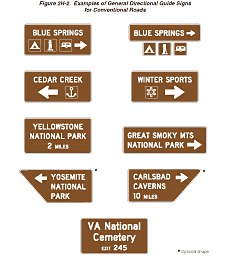
Support:
Figure 2H-3 illustrates typical height and lateral mounting positions.
Figure 2H-4 illustrates some examples of placement of symbol signs
within a recreational or cultural interest area. Figure 2H-5 illustrates
some of the symbols that can be used.
Figure 2H-3 Height and Lateral Position of Signs Located Within Recreational and Cultural Interest Areas
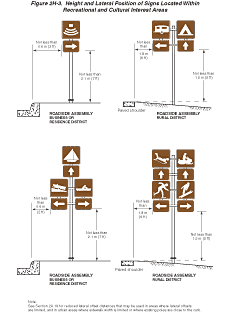
Figure 2H-4 Examples of Symbol Signing Layout
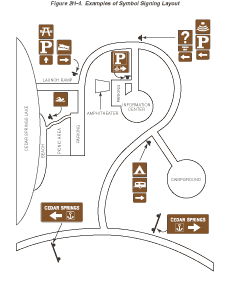
Figure 2H-5 Recreational and Cultural Interest Area Symbol Signs (5 Sheets)
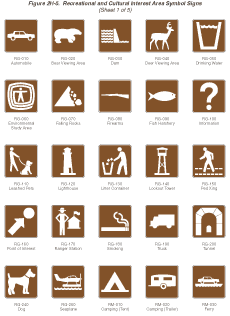

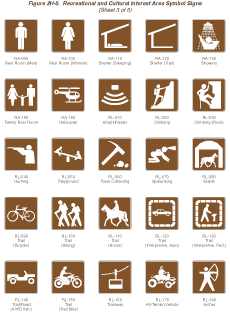
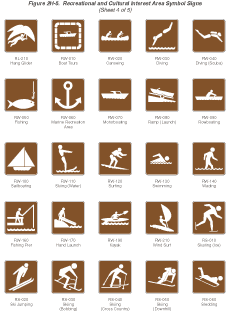

Guidance:
The number of symbols used in a single sign assembly should not
exceed four.
Option:
Symbols for recreational or cultural interest areas may be used
as legend components for a directional sign assembly. The symbols
may be used singularly, or in groups of two, three, or four on a
single sign assembly (see Figures 2H-1, 2H-3, and 2H-4). Smaller-size
secondary symbols (see Figure 2H-1) may be placed beneath the primary
symbols, where needed.
Section 2H.09 Destination Guide Signs
Guidance:
When recreational or cultural interest area destinations are shown
on supplemental guide signs, the sign should be rectangular or trapezoidal
in shape. The order of preference for use of shapes and colors should
be as follows: (1) rectangular with a white legend and border on
a green background; (2) rectangular with a white legend and border
on a brown background; or (3) trapezoidal with a white legend and
border on a brown background.
Standard:
Whenever the trapezoidal shape is used, the color combination shall
be a white legend and border on a brown background.
Option:
White-on-brown destination guide signs may be posted at the first
point where an access or crossroad intersects a highway where recreational
or cultural interest areas are a significant destination along conventional
roads, expressways, or freeways. White-on-brown supplemental guide
signs may be used along conventional roads, expressways, or freeways
to direct road users to recreational or cultural interest areas.
Where access or crossroads lead exclusively to the recreational
or cultural interest area, the advance guide sign and the exit direction
sign may be white-on-brown.
Standard:
Linear parkway-type highways that primarily function as arterial
connectors, even if they also provide access to recreational or
cultural interest areas, shall not qualify for the use of white-on-brown
destination guide signs. Directional guide signs used on these highways
shall conform to Chapter 2D.
All gore signs shall have a white legend and border on a green background. The background color of the interchange exit number panel shall match the background color of the guide sign. Design characteristics of conventional road, expressway, or freeway guide signs shall conform to Chapter 2D or 2E except as specified in this Section for color combination.
The advance guide sign and the Exit Direction sign shall retain the white-on-green color combination where the crossroad leads to a destination other than a recreational or cultural interest area.
Support:
Figure 2H-2 illustrates destination guide
signs commonly used for identifying recreational or cultural interest
areas or facilities.
